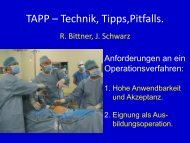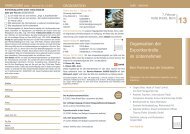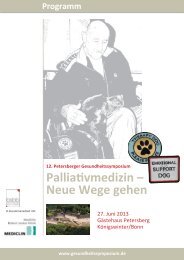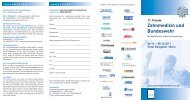day 1 - Bsbb
day 1 - Bsbb
day 1 - Bsbb
You also want an ePaper? Increase the reach of your titles
YUMPU automatically turns print PDFs into web optimized ePapers that Google loves.
A multiparameter approach to assestotal- and partial-body irradiation in ababoon modelFrancis HérodinInstitut de Recherche Biomédicale des ArméesCONRAD Conference - Munich 13 - 16 May 2013
Rationale• The use of IND and RED by terrorists would lead to anunpredictable ratio of TBI and PBI.• The DCA alone may not distinguish TBI (requiring specifichematologic support) and PBI with low level of BMshielding (spontaneous recovery likely to be expected).• PBI studies in mice suggest that the site of exposuredictates the biologic response (Meadows 2010), but– malevolent exposures would not be organ-targeted– human response to radiation is characterized by anintrinsic heterogeneity (corpulence) not seen in mice• à There is a need of relevant biomarkers of heterogeneityand injury for PBI versus TBI (diagnosis and prognosis),also usable for late disclosed radiation accidents.
A study designed to account for accidentalexposures and discriminate between PBI and TBI• Adult male baboons (24.1 + 5.1 kg) as a large animal modelrelevant to human• A unilateral irradiation to simulate accidental exposures as ittakes into account the dose distribution heterogeneityinherent to human and non-human primates• Two total- and four partial-body exposures equivalent to5 Gy TBI were compared. Two exposures equivalent to 2.5Gy TBI were also studied.• A multiparameter approach chosen to discriminate betweenPBI and TBI (Prasanna et al. 2010, Hérodin et al. Health physics,2012;103:143–149).
Exposures equivalent to 5 Gy TBIN=2Unilateral irradiation to simulatedocumented radiation accidentsà gradient of dose distributionfront to back = 2.9 for exposedareas in all situations à evenTBI are non uniform exposuresN=25 Gy TBI 2.5 Gy / 7.5 Gy TBIN=1N=2N=2N=3 N=215 Gy PBI 30%10 Gy PBI 50% 6.25 Gy PBI 80% 6.25 Gy PBI 80% 5.55 Gy PBI 90%
Multiparameter approach (>50)• Clinical parameters (needs for medical care)• 21 Hematological p. (incl. bone marrow & coagulation)• 30 Biochemical parameters (incl. inflammation):– Albumine, Cl, Na, K, Mg, Lactate, ALT, AST, Amylase,CK, LDH, ALP, Cholesterol, Tg, urea, creatinine,glucose, citrullin, Flt3-L, Iron, C3c, CRP, haptoglobin,orosomucoid, transferrine, SAA, IL-6, HMGB1, EPO.• Genomics (in progress)• Cytogenetics (dicentric assay)BL TBI H1, 6, 12, Day 1, 2, 3, 4, 5, 7, 10, 14, 17, 21, 24, 28, 35, 42, 60, 90…, 200.PBI
Results• Statistics• Clinic• Cytogenetics• Hematology• Biochemistry
Statistical analysis: PLS-DA• Soft independent modelling by class analogy (S.I.M.C.A.) is apredictive method using a non linear iterative partial least square(N.I.P.A.L.S.) algorithm.• This method allows to classify individuals from small groups.
Clinical statusCLINICAL SIGNS AND SYMPTOMS AFTER IRRADIATIONvomiting diarrheaerythemaexposed skintransienthairloss petechiae body weightlossfever5 Gy TBI7.5 Gy / 2.5 Gy TBI5.55 Gy PBI 90%~ 2 hoursmoderate<strong>day</strong>s4 - 6 <strong>day</strong> 22<strong>day</strong> 155 - 10%6.25 Gy PBI 80%10 Gy PBI 50%<strong>day</strong>s3 - 5<strong>day</strong>s4 - 6<strong>day</strong> 18on 8 - 18%< 1.5°C15 Gy PBI 30% <strong>day</strong> 2 desquamation<strong>day</strong>s 21 - 28 4 - 8%No alteration of food intake, no change in behavioral status.
Dicentric assay (<strong>day</strong> 1)1,42.5 Gy TBI and5 Gy 50% PBIhave equivalentdicentricfrequencies.Dicentric frequency1,210,80,60,40,205 Gy TBI haveover 3x moredicentrics than10 Gy 50% PBI2.5 Gy TBI5 Gy 50% PBI5 Gy TBI7.5Gy/2.5Gy TBI15 Gy 30% PBI10 Gy 50% PBI6.25Gy 80% PBI6.25Gy 80% PBI (Head Protected)5.55Gy 90% PBI0 1 H 1 D 28 D200 D9
Have a look at Poster 15-5 (M. Valente)Dicentric assay1 Hour and 6 Hours after IRRMost PBI not detected.“Gold Standard” for BiodosimetryMore reliable for TBI than PBIPBI estimations (Dolphin method)Day 1All TBI and all PBI but one correctly diagnosed.Day 28 and Day 200Almost all diagnosedas PBI (even TBI)0 1 H 1 D 28 D200 D10
Hematology
70015 Gy PBI 30%1000ANC (% of baseline)60050040030020010010 Gy PBI 50%6.25Gy PBI 80%5.55Gy PBI 90%7.5Gy/2.5Gy TBI5 Gy TBI1001015 7 10 14 17 21 24 28 35000.2513AbsoluteNeutrophiland5Lymphocytecounts10172435Days after irradiation60Lymphocyte count (% of baseline)100908070605040302010011916815 Gy PBI 30%10 Gy PBI 50%6.25Gy PBI 80%5.55Gy PBI 90%7.5Gy/2.5Gy TBI5 Gy TBI0 0.04 0.25 0.5 1 2 3 4 5 7Days after irradiation
140Platelet count (% of baseline)1201008060402015 Gy PBI 30%10 Gy PBI 50%6.25Gy PBI 80%5.55Gy PBI 90%7.5Gy/2.5Gy TBIPlatelet CountandHemoglobin level05 Gy TBI00.251351017243560110119168Days after irradiationHemoglobin (% of baseline)100908070605015 Gy PBI 30%10 Gy PBI 50%6.25Gy PBI 80%5.55Gy PBI 90%7.5Gy/2.5Gy TBI4000.2513510172435Days after irradiation605 Gy TBI119168
FLT-3 Ligand (ng/L)3 5003 0002 5002 0001 5001 00015 Gy PBI 30%10 Gy 50% PBI6.25 Gy PBI 80%5.55 Gy PBI 90%7.5 Gy / 2.5 Gy TBI5 Gy TBI2.5 Gy TBI50000 2 4 7 14 21 35 64 119 201Days after irradiationFlt-3 ligand level
Bone marrow assessment• Hematopoietic progenitors (CFU)Dose dependentdecrease inexposed areasstart ofrecoveryOverall completerecovery0 1 D 42 D200 D• Multi-site sampling of CD34 + cells: early indicatorof inhomogeneous exposure
Biochemical markers
CRP (mg/L)1201008060405 Gy TBI10 Gy PBI 50%7.5/2.5 Gy TBI6.25 Gy PBI 80%5.55 Gy PBI 90%15 Gy PBI 30%20000.251351017243560120Days after irradiation• CRP level peaks at <strong>day</strong> 1 for all situations.• As for fibrinogen levels, no distinction between PBI and TBI could beseen using CRP.
Small bowel injury: citrulline level160Citrulline (% of baseline)1401201008060402005 Gy TBI 10 Gy PBI 50%7.5Gy/2.5Gy TBI 6.25Gy PBI 80%5.55Gy PBI 90% 15 Gy PBI 30%01351017243560Days after irradiation119168Distinction between PBI and TBI possible from <strong>day</strong> 2
What about other early bioindicators ?• EPO plasma levels252015 Gy PBI 30%10 Gy PBI 50%6.25 Gy PBI 80%5.55 Gy PBI 90%7.5 / 2.5 Gy TBI5 Gy TBIEPO (IU/mL)1510500 1 2 7Days after irradiation
Discussion and Perspectives• This in vivo study focused on potentially confoundingsituations which therefore called for a multiparameterapproach.• First <strong>day</strong>s:– At <strong>day</strong> 1, DCA can discriminate between 5 Gy TBI andequivalent PBI from 30% to 90% BM exposed.– Bio-markers: ANC, N/L ratio, CRP, citrulline.• Between 10 and 21 <strong>day</strong>s:– TBI vs PBI discrimination possible using ANC, PLT, Hb,Flt-3 ligand (clinical re-evaluation of heterogeneouslyexposed individuals).• This model should be tested for a larger dose range of TBIand PBI. New markers such as circulating miRNA or organspecificindicators to be investigated.• A careful interpretation should be made (small size of thegroups).
AcknowledgmentsIRBA / CRSSA• Marco Valente• Nancy Grenier• Stéphane Baugé• Josiane Denis• Jean-François Mayol• Hervé Chaussard• Patrick Martigne• Michel DrouetCollaborations• Pr Michael Abend (IRBW):gene expression analysis• Dr George Sigal (Meso ScaleDiagnostics): multiplexedplatform for serum proteins










